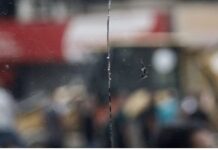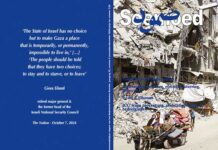Tareq S. Hajjaj
Mondoweiss / August 22, 2024
Over the past week, the Israeli army has ordered a million civilians to evacuate central Gaza, and has bombed two schools sheltering displaced people in Gaza City mere minutes after issuing warnings.
On Wednesday, August 21, the latest Israeli evacuation warnings fell out of the sky over the most crowded part of Gaza, Deir al-Balah in the center of the besieged enclave. The leaflets and phone calls from the Israeli army referenced a map informing people which numbered block would be targeted for an imminent invasion. These are the tools the Israeli army uses to control where people in Gaza move, forcing them to evacuate from one area to another over and over again.
Last week, evacuation orders were sent to areas in Khan Younis and Nuseirat to the south, causing a mass exodus to Deir al-Balah. Those same refugees now have to move yet again, but Khan Younis and parts of Nuseirat are still in critical danger due to the ongoing Israeli invasion. There is nowhere left to go.
In a press release last Sunday, the Deir al-Balah municipality said that the waves of evacuation reaching Deir al-Balah were causing an unprecedented number of displaced people to cram into a tiny zone. According to the statement, Deir al-Balah’s total area is 42 square kilometers, and almost a million displaced people are now distributed across 200 displacement centers there.
“This makes Deir al-Balah the most crowded displacement camp in history,” the municipality said.
On Tuesday, the Israeli army bombed the local market in Deir al-Balah, killing 9 civilians. Several hours later, the army bombarded a school in Gaza City sheltering 700 people, killing 10 people, according to the Palestinian Civil Defense.
Civil Defense teams were forced to cut up a martyr’s body to pull him out of the rubble, which had been stuck under three collapsed ceilings inside the school. Survivors say that it was one of the most horrific scenes they have witnessed since the start of the war.
Testimonies from the Gaza City school bombing
The Mustafa Hafez School is located in the al-Rimal area east of Gaza City. It is the ninth school hosting refugees to be bombed in recent weeks, according to a statement released by the Gaza Civil Defense on Tuesday.
Motaz al-Kafarneh, 44, was trying to take a nap when the school was hit. The rooms in the school where he, his brother, and their families lived were only a few meters away. When the explosion occurred, all his family members were thrown out of their rooms from the force of the blast.
“We ran looking for our children. What we found was a place full of bloodstains and body parts,” Motaz told Mondoweiss. “The little children, one and two years old, were blown out of the building as a result of the explosion. We started looking for them after the explosion, and found them outside on the street.”
Motaz says that he and his family had been sure that the school was safe and far away from any fighting. “Only civilian families live here. Most of them are women, children, and the elderly. There is no danger or anything suspicious going on around this school.”
“But any assumptions we had were misplaced. We were bombed inside a shelter,” he said, describing how he pulled his sister-in-law and her children out from under the rubble. “Some of them survived, others we couldn’t find.”
Motaz says he could not comprehend what was happening. He himself was running from one place to another trying to search for his family members amid the rubble.
“If my family and I had been a few meters closer, we would have been killed,” he said. “It is God’s will that has kept us alive.”
Adham Hajila, 13, a resident of the Shuja’iyya neighborhood in Gaza City who lost his home at the start of the war, talks about the charred and dismembered bodies he saw after the explosion. “The bodies come out like ghosts,” he told Mondoweiss. “They will remain in the school and will not leave it.”
“The martyrs were disfigured. They were burned and dismembered; every part of the human body is gone somewhere, and others remain under the rubble. Every time I close my eyes, I can see it all again.”
Adham and his family of five decided to stay in the school even after the strike because there is no place left to go. Adham lives in a constant state of shock, but what makes it worse is that he continues to live in the same place where it all happened. “I can still smell the blood in the school,” he said.
Ramzia al-Kafarneh, a mother of a displaced family in the school, describes the aftermath of the attack as “another massacre.” She says the lack of capabilities to retrieve the bodies from under the rubble, and the difficulties encountered by ambulances and Civil Defense crews in reaching the bombed areas, turned the site into a death pit for several days, until most of the dead were retrieved. Others who could not be reached are still under the rubble in various stages of decomposition.
“I live in a shelter full of children and families, and the children were playing in the schoolyard, and suddenly they bombed the school, and rubble, stones, and shrapnel began to fall on the heads of our children,” Ramzia told Mondoweiss. “We ask the world and say, ‘where do we go?’ The schools aren’t safe, the displacement centers aren’t safe. We’re afraid to sleep in shelters now. Where do we go? The street? Even the streets are not safe. There is no safety in Gaza at all.”
Ramzia recalled the moments she lived through and the terror she experiences when stones and shrapnel fell above her head.
“There is no threat in the shelter,” Ramzia says adamantly. “There are no militants, there are no resistance fighters here. It is a displacement center for families only.”
Death rains over Salah al-Din School
During the writing of this report on Wednesday, the Israeli army bombed another school in the Jalaa’ area in Gaza City, killing three people. The army warned people via phone calls to evacuate the area only five minutes before the bombardment occurred. Survivors of the bombing at the targeted shelter, the Salah al-Din School, relayed their testimonies to Mondoweiss.
At the entrance to the school, an 81-year-old elderly woman, Muna al-Jarousha, told Mondoweiss that she lost her children and grandchildren, who were close to the bombing. They were staying in the shelter on al-Jalaa’ Street, north of Gaza City, when shrapnel suddenly started flying at them.
“The Israelis warned us, they called us and told us to evacuate the place within five minutes,” she said. “Everyone started running out and screaming without knowing why, and there were still people who did not receive the evacuation message. Most of them were unable to evacuate. They were either martyred, lost, or injured.”
Muna says that the bombing tore her family members apart and scattered them in different directions. Unable to move, she sat a distance away from the bombing site and tried to spot her children or grandchildren.
“I was trying to go out to look for my family after hearing the terrifying sound,” she said. “Moments after the bombing, my son’s daughter came, raising her bleeding hand, her finger cut off by shrapnel. Her brother was injured in the stomach, causing his intestines to spill out of his abdomen. My son’s wife was injured in the head, and my daughter’s son disappeared and we have not been able to find him until now.”
“We have not recovered all my children and grandchildren yet, and we do not know where they are. They could be alive or buried under the rubble, or they could have been cut up by the blast and lost forever, gone without a trace.”
The three recorded deaths in the Salah al-Din school were all children.
Tareq S. Hajjaj is the Mondoweiss Gaza Correspondent, and a member of the Palestinian Writers Union
Fatima Hassouneh and Mahmoud Abu Hamdah gathered testimonies for this report












